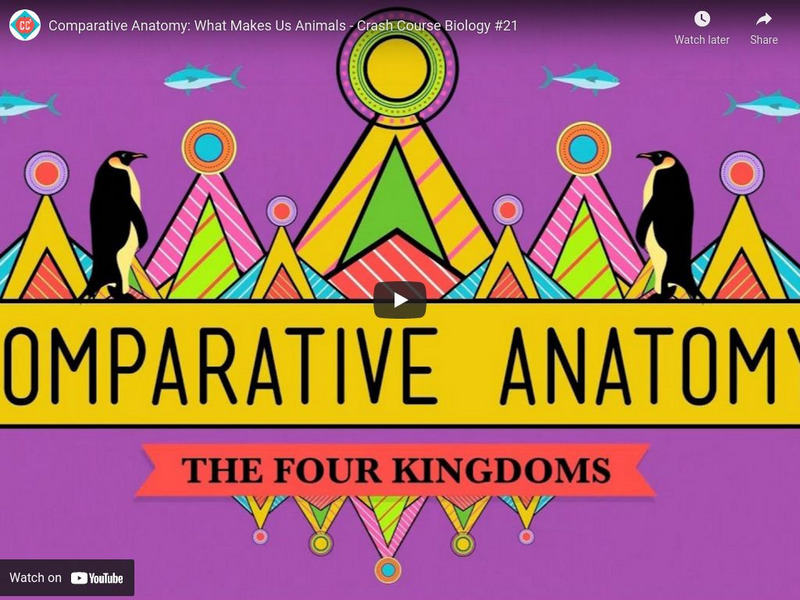Crash Course
Comparative Anatomy: What Makes Us Animals - Crash Course Biology
Hank introduces us to comparative anatomy, which studies the similarities and differences in animal anatomy to support the theory of evolution and the shared ancestry of living things.
SciShow
This Is What Peak Crustacean Looks Like
We may think of a lot of critters with crab-like body plans as crabs, but, technically, many of them are other types of crustaceans. So why do they share so many physical traits?
SciShow
How These Snakes Evolved to Spit… IN YOUR EYE
If you spook a spitting cobra, it might literally shoot venom at your eyes... And our ancestors might have caused them to do this, evolutionarily speaking.
SciShow
The Bizarre World of Animal Flight | Compilation
Flying is a great way to get around, but humans have only been doing it for a little over a century. Let’s revisit six SciShow videos exploring the world of flying non-human animals, which includes some species that you might not expect!
SciShow
5 of the Strangest Prehistoric Crocs
Over the years, scientists have found evidence for a lot of weird prehistoric animals, but some of the strangest have been the crocodyliformes! Chapters MOURASUCHUS: THE WHALE CROCS 1:26 KAPROSUCHUS: THE BOAR CROC 3:21 ARMADILLOSUCHUS:...
SciShow
How Is That Not Killing You?
When Hank watches nature documentaries he always comes away with one big question: how is that not killing you? In today's episode of SciShow he looks at three unusual ways that animals manage not to get killed by nature.
SciShow
How People Have Evolved to Live in the Clouds
High elevations can be a problem for humans. Since the air is thinner, you get less oxygen with every breath, leading to all kinds of negative side effects. But there are millions of people around the world who spend their whole lives at...
Bozeman Science
Coevolution
Paul Andersen explains the concept of coevolution. He begins with an analogy comparing the relationship of humans to technology with those of coevolving species. He then discriminates between coevolution and convergent evolution. He...
SciShow
Dire Wolves Were Real! But Not Wolves
When you hear the words dire wolf, your mind might jump to Game of Thrones or Dungeons and Dragons, but dire wolves are not just in the realm of fantasy and fiction. They were real animals that lived during the last Ice Age, and we're...
Be Smart
How Evolution Turned A Possum Into A Wolf
Until the early 20th century, Tasmania was home to a very weird wolf-like creature. Except that it wasn't a wolf. Even though it looked like a wolf. How did that happen? Here's the science of convergent evolution!
Nature League
"Life" on Venus and other nature news from September 2020
In this episode of Nature League, Brit breaks down some life on Earth news from September of 2020, including baboon social structure, Australian stinging trees, and life-related molecules on Venus. Written, edited, and presented by: Brit...
Bizarre Beasts
Tenrecs Will Not Stay In Their Lane
If all crustaceans “want” to look like crabs, then tenrecs “want” to look like basically any other small mammal. These weird little guys are endemic to Madagascar – they’re native to nowhere else on Earth.
Brave Wilderness
SNAKE CHALLENGE - Which one is Deadliest?!
On this episode of On Location, Coyote and Mario are in DeLand, Florida at the Reptile Discovery Center! Coyote decides to put Mario to the challenge, since he's a snake enthusiast.. can Mario name one fact about every snake inside of...
Curated Video
Raptors: From Owls to Falcons
This video discusses the fascinating world of raptors, focusing on the two remaining families of primarily nocturnal owls. It explores their evolution from dinosaurs and their unique adaptations for hunting and scavenging. The video also...
Professor Dave Explains
Cladistics Part 1: Constructing Cladograms
Before we dive into learning about all the different kinds of animals, we have a little bit of work to do. How do we describe the relationships between animals? How does phylogeny work? We have to learn about cladistics, which means we...
msvgo
Evidences of Evolution
The nugget explains various evidences that favors organic evolution. Describe the importance of tracing evolutionary relationships.
Getty Images
Anemone crab (family Porcellanidae) feeding, Kungkungan Bay Resort, Lembeh Strait, Sulawesi, Indonesia
Anemone crab (family Porcellanidae) feeding, Kungkungan Bay Resort, Lembeh Strait, Sulawesi, Indonesia
Getty Images
Pink coral, Mayne Rock, Sabah, Malaysia, Borneo
Pink coral, Mayne Rock, Sabah, Malaysia, Borneo
Crash Course
Crash Course Biology #21: Comparative Anatomy: What Makes Us Animals
Hank introduces us to comparative anatomy, which studies the similarities and differences in animal anatomy to support the theory of evolution and the shared ancestry of living things. [8:51]

